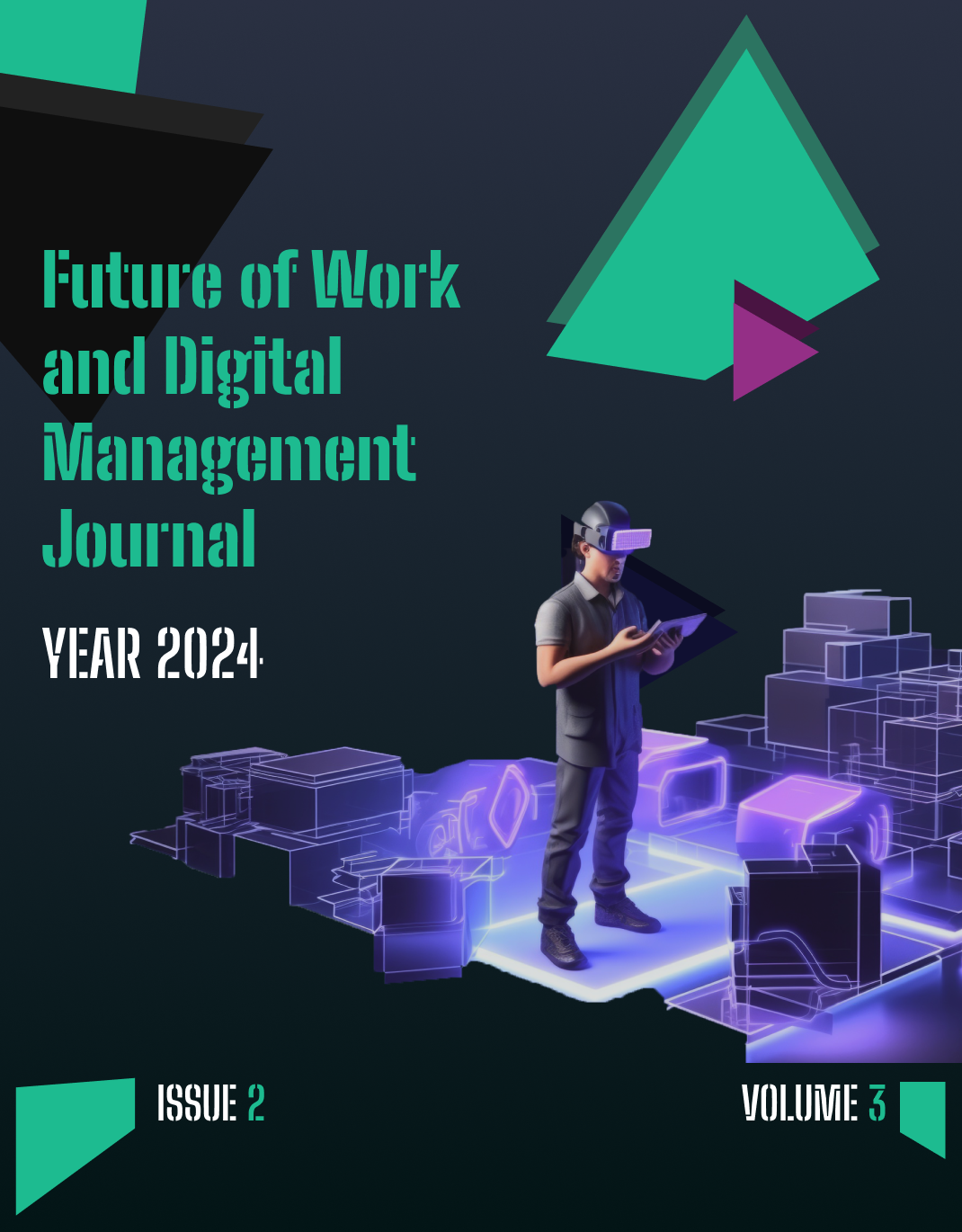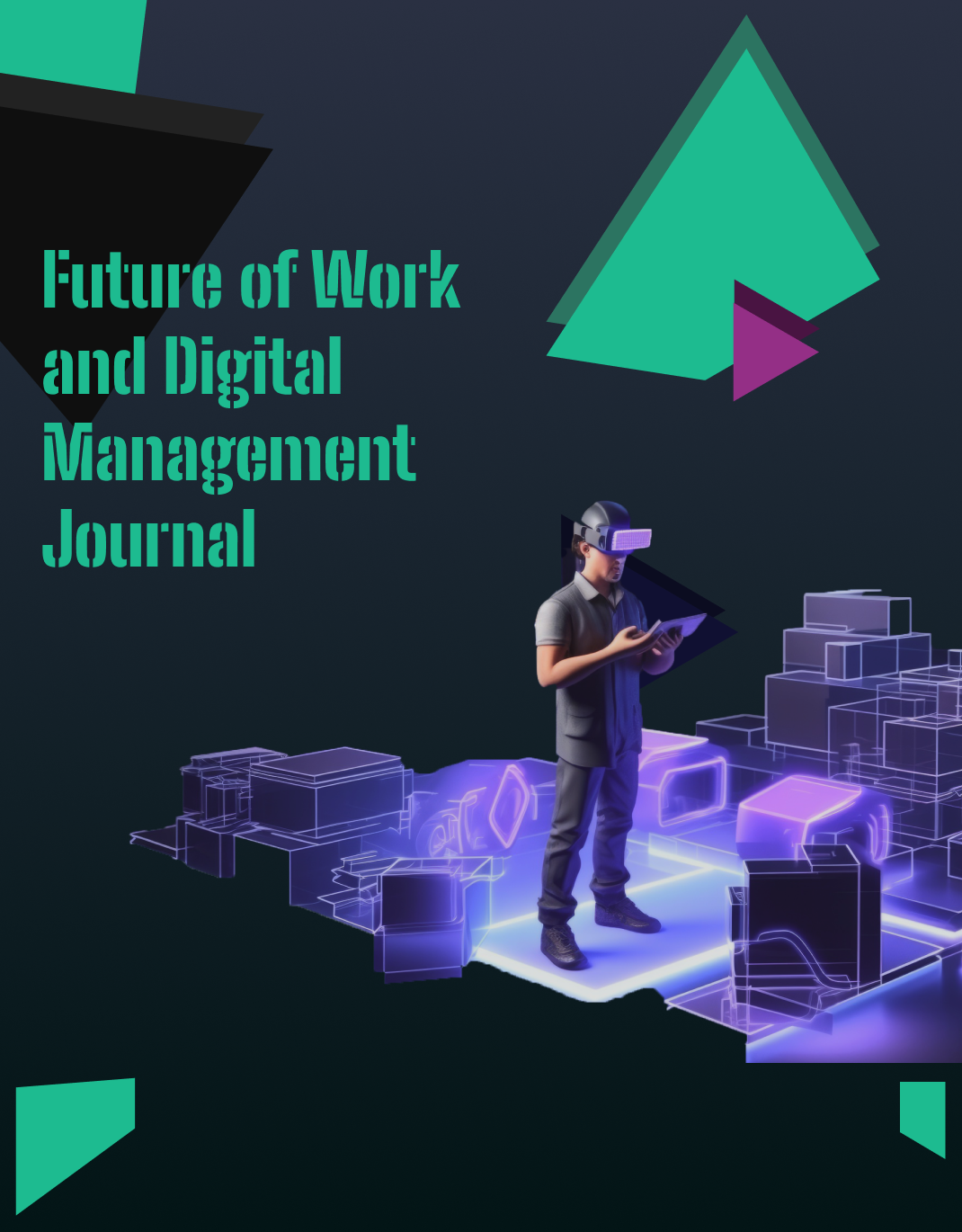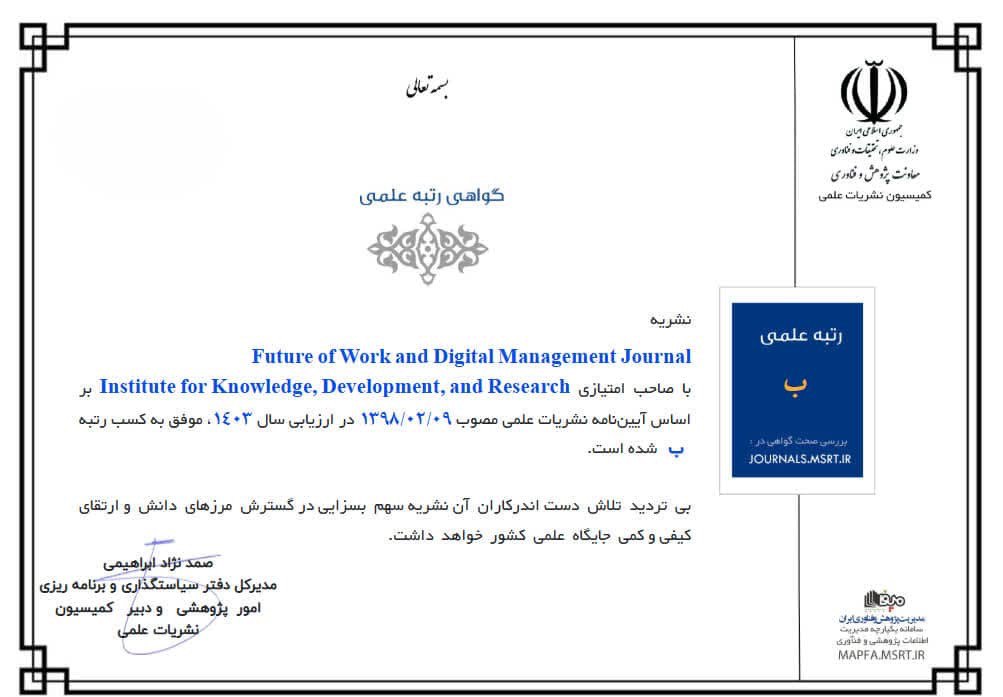Developing a Model of Human Resource Excellence in the Digital Era
Keywords:
Human Resource Excellence, Digital Era, Artificial IntelligenceAbstract
The primary objective of this study is to develop a model of human resource excellence in the digital era. The research employed a mixed-methods approach (qualitative and quantitative). In the qualitative phase, data were collected through thematic analysis and the Delphi technique. The qualitative statistical population consisted of professors and experts in the field of human resources. Using purposive sampling, 12 experts were selected for the extraction of initial data (interviews), and 7 experts were selected to provide feedback in the Delphi process. Thematic analysis was conducted using the Attride-Stirling method with the aid of NVivo software. The results yielded 129 open codes, 50 basic codes, 15 organizing codes, and 3 global themes. In the quantitative phase, the statistical population comprised 1,200 experts and managers in the fields of human resources and technology across the country. Based on Cochran’s formula, a sample size of 291 participants was determined. Quantitative data were analyzed using SPSS and SmartPLS software. The findings of this study indicate that the model of human resource excellence in the digital era consists of three main dimensions: (1) Implementation Space (path coefficient = 0.384), with components including nature, formulation, environment, evaluation, and technology; (2) Human Resource Space (path coefficient = 0.353), with components including performance, goal setting, executive tools, control, and meritocracy; and (3) Digital Era Space (path coefficient = 0.301), with components including technological conditions, economic conditions, political conditions, communication barriers, and the structure of intelligent organizations. Among these, the Implementation Space, Human Resource Space, and Digital Era Space exert the greatest influence, respectively, on the formation of the model of human resource excellence in the digital era. Furthermore, within the Implementation dimension, the component of nature (path coefficient = 0.801) was identified as the most significant factor; within the Human Resource dimension, the performance component (path coefficient = 0.844) was found to be the most influential; and within the Digital Era dimension, technological conditions (path coefficient = 0.900) emerged as the most critical component.
Downloads
References
[1] A. H. Al-Qassem, "The Impact of Technological Advancements on Human Resource Management Practices: Adapting to the Digital Era," Data & Metadata, vol. 4, p. 731, 2025, doi: 10.56294/dm2025731.
[2] R. Indradevi, N. Sathya, and B. Baskar, "Technology-Enabled HR Practices for Successful Implementation of SHRM," International Research Journal of Multidisciplinary Scope, vol. 5, no. 2, pp. 427-440, 2024, doi: 10.47857/irjms.2024.v05i02.0529.
[3] A. Karuppannan, M. Maheswari, R. Hemamalini, M. Ramakrishnan, and K. S. Rangasamy, "E-HRM - Transforming Human Resource Management in the Digital Age: A Conceptual Study," Tfe, vol. 2, no. 2, pp. 14-19, 2024, doi: 10.46632/tfe/2/2/2.
[4] M. A. Pande, R. M. Bangur, and V. Tanwar, "Exploring the Impact of HR 4.0 on Organizational Performance," International Journal of Information Technology and Management, vol. 19, no. 1, pp. 32-40, 2024, doi: 10.29070/mqxkzc33.
[5] Y. Dahliani, A. Sumady, and R. Rohmial, "Developing Agile Workforce Strategies: The Role of HR in Fostering Innovation and Adaptability in Organizations," Ijsh, vol. 2, no. 1, pp. 28-36, 2025, doi: 10.59613/7x8d3p15.
[6] U. M. Kachalla and H. B. Adamu, "Adoption of Human Resource Technology (HRT): Its Implication on Entrepreneurs and Micro Scale Industries’ (MSI) Employee Performance in Yobe State," Journal of Advanced Research and Multidisciplinary Studies, vol. 4, no. 3, pp. 127-138, 2024, doi: 10.52589/jarms-lwpt6sh9.
[7] A. C. Schulz, D. Cürlis, C. Goretzky, D. H. Kruger, B. Pelka, and L. Preissner, "Enabling Technology Hand in Hand With Enabling Practices," Journal of Enabling Technologies, vol. 18, no. 2/3, pp. 76-90, 2024, doi: 10.1108/jet-01-2024-0008.
[8] R. N. Vadithe and B. Kesari, "Role of Technology Enablers for Implementation of HR Analytics in the Indian IT Sector: A Mediation Analysis," Human Systems Management, 2025, doi: 10.1177/01672533251314403.
[9] H. Dadheech, "AI-Driven HR Analytics: Unleashing the Power of HR Data Management," Shanlax International Journal of Management, vol. 11, no. S1-Mar, pp. 163-171, 2024, doi: 10.34293/management.v11is1-mar.8098.
[10] J. Westover, "The Future of HR Education," HCLReview, vol. 17, no. 3, 2025, doi: 10.70175/hclreview.2020.17.3.1.2.
[11] S. Subrahmanyam, "Role of Artificial Intelligence in Re-Inventing Human Resource Management (HRM) 2.0," 2025, pp. 243-264.
[12] T. Shenbhagavadivu, K. Poduval, and V. Vinitha, "Artificial Intelligence in Human Resource: The Key to Successful Recruiting and Performance Management," Shodhkosh Journal of Visual and Performing Arts, vol. 5, no. 6, 2024, doi: 10.29121/shodhkosh.v5.i6.2024.1351.
[13] T. M. Kanade, "The Evolution of HR," 2025, pp. 49-78.
[14] D. R. L, "Synergizing Human Resource Management, Accounting, and Artificial Intelligence: A Path to Future Success," International Journal for Research in Applied Science and Engineering Technology, vol. 13, no. 2, pp. 1552-1556, 2025, doi: 10.22214/ijraset.2025.66281.
[15] J. Pak, H. H. Ghaleh, Z. Ma, and M. N. Akhtar, "Antecedents and Outcomes of Enabling HR Practices: The Paradox of Consistency and Flexibility," Human Resource Management Journal, vol. 35, no. 2, pp. 371-396, 2024, doi: 10.1111/1748-8583.12571.
[16] B. Ghlichlee, "HR Excellence Enablers and Results: Developing a Scale for Assessing Key Internal and External HR Stakeholders’ Perceptions," Management Research Review, vol. 47, no. 6, pp. 964-983, 2024, doi: 10.1108/mrr-11-2022-0807.
[17] V. S. Rana, "Impact of HR Practices on Job Opportunities and Career Advancement in the Hospitality Industry," Journal of Social Responsibility Tourism and Hospitality, no. 41, pp. 29-37, 2023, doi: 10.55529/jsrth.41.29.37.
[18] S. K. R. Kumar, "Influence of Sustainable Human Resource Practices on ITES Organizational Culture," Journal of Information Systems Engineering & Management, vol. 10, no. 13s, pp. 522-530, 2025, doi: 10.52783/jisem.v10i13s.2107.
[19] A. Tretiakov, T. Jurado, and J. Bensemann, "Employee Empowerment and HR Flexibility in Information Technology SMEs," Journal of Computer Information Systems, vol. 63, no. 6, pp. 1394-1407, 2023, doi: 10.1080/08874417.2022.2158962.
[20] A. Sonar and R. K. Pandey, "Human Resource (HR) Practices - A Comprehensive Review," Management Journal for Advanced Research, vol. 3, no. 5, pp. 42-56, 2023, doi: 10.54741/mjar.3.5.5.
[21] S. Vashisht, U. Mangal, N. Chaudhary, and M. Q. Rezvani, "Enhancing Business Excellence Through the Evaluation and Prioritization of HR Practices," International Journal of Business Excellence, vol. 1, no. 1, 2023, doi: 10.1504/ijbex.2023.10062979.
[22] P. M. Jangam, "HR Audit 2.0: Empowering Employee Performance in Futuristic Management Trends," 2024, pp. 29-34.
[23] F. A. Tuli, "Transforming Talent Management: The Journey to E-Human Resources Excellence," Asian Business Review, vol. 13, no. 2, pp. 29-38, 2023, doi: 10.18034/abr.v13i2.685.
Downloads
Published
Submitted
Revised
Accepted
Issue
Section
License
Copyright (c) 2024 Alireza Tahoori, Davood Paydarfard, Yaghob Alavi Matin (Author)

This work is licensed under a Creative Commons Attribution-NonCommercial 4.0 International License.








